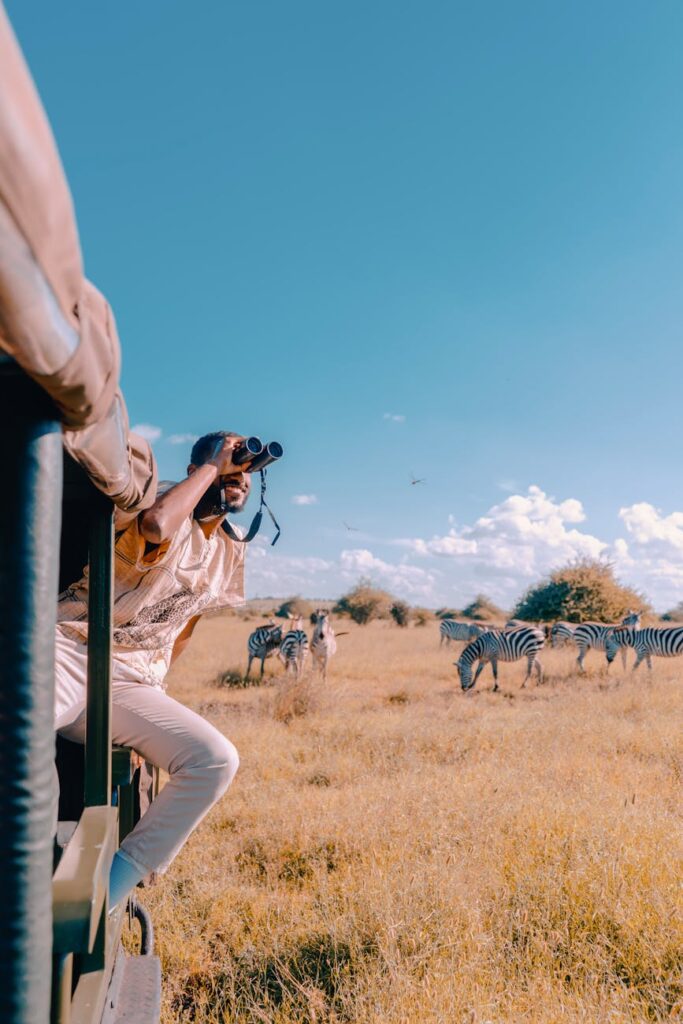Mastering Binocular Adjustments
To maximize the effectiveness of your binoculars during wildlife spotting, mastering the art of binocular adjustments is essential. These techniques will enhance your viewing experience and allow you to observe wildlife with clarity and precision.
Adjusting Eye Cups and Width
Before venturing into the wild, ensure you’ve customized your binoculars for optimal viewing. Start by adjusting the eye cups. If you wear glasses, you may need to twist the eye cups down; if not, twist them up. This adjustment helps keep your eyes at the correct distance from the lenses, providing a full field of view. The width of the binoculars should then be adjusted. Pivot them on the hinge until you see a single circular view. Remember to use your binocular neck strap or a binocular harness to keep the binoculars secure and accessible (Deschutes Land Trust).
To accommodate for differences between your eyes, you’ll also want to adjust the diopter focus. This is usually located on the right eyepiece and fine-tunes the focus to match your vision. Once set, you should not have to adjust the diopter frequently.
Achieving Sharp Focus
Achieving a sharp focus is vital for identifying the fine details of wildlife. Begin by holding your binoculars steady and selecting a static object to focus on. Using both eyes, turn the central focusing wheel until the image is clear. Then, close your right eye and refine the focus using the central wheel for your left eye only. Switch and adjust the diopter for your right eye while keeping the left eye closed. Alternate between eyes until you achieve a crisp image.
These steps should be repeated whenever you’re viewing objects at significantly different distances. Regular practice will make the process quicker and more intuitive, ensuring you don’t miss any fleeting wildlife moments (Alaska Department of Fish and Game).
For those just beginning their journey into wildlife observation, understanding the basics of binoculars can greatly improve the experience. And as you delve deeper into the world of optics, consider exploring high-end binoculars for unparalleled clarity, or budget-friendly optics if you’re just starting out. Whatever your choice, mastering these binocular adjustments is a step toward becoming a proficient wildlife observer.
Choosing the Right Binoculars
Selecting the perfect binoculars can enhance your wildlife spotting experience significantly. Essential aspects like magnification, lens diameter, and specific features can make a substantial difference in your field observations.
Ideal Magnification and Lens Diameter
When choosing binoculars for wildlife viewing, magnification and lens diameter are two critical specifications to consider. Binoculars are commonly described by a set of numbers, for example, 8×42. The first number represents the magnification power, indicating how many times closer the subject appears compared to the naked eye. The second number refers to the diameter of the objective lens in millimeters, which determines how much light is captured, affecting the brightness and detail of the image.
| Activity | Magnification | Lens Diameter (mm) |
|---|---|---|
| General Wildlife Viewing | 7x to 10x | 30 to 42 |
| Birdwatching | 8x | 25 to 40 |
For birdwatchers, a magnification of 7x or 8x is often ideal as it provides a wide field of view and stable image. The lens diameter should be between 25 and 40 millimeters to ensure sufficient light intake without being too cumbersome (Deschutes Land Trust).
When considering magnification power in scopes, remember that higher magnification can result in a narrower field of view and may require a steadier hand or a tripod for stability. Therefore, it’s important to strike a balance based on your specific needs and the type of wildlife you intend to observe. For more detailed information, check out our binocular buying guide.
Features for Wildlife Viewing
Beyond magnification and lens size, there are additional features that can contribute to an effective and enjoyable wildlife spotting experience:
- Waterproof and Fogproof: Binoculars designed to withstand different weather conditions are essential for outdoor activities. Look for models that are O-ring sealed and nitrogen or argon purged to prevent internal fogging.
- Durability: A rugged construction can protect your binoculars from the inevitable bumps and drops during outdoor expeditions.
- Eye Relief: Adequate eye relief is crucial for comfort, especially for those who wear glasses. A longer eye relief allows you to hold the binoculars further from your eyes while still seeing the entire field of view.
- Weight and Ergonomics: Lightweight and well-balanced binoculars reduce fatigue during long periods of use. Ergonomic grips and thumb indents can also enhance handling.
- Optical Coatings: Quality coatings on lenses improve light transmission and reduce glare, resulting in clearer and sharper images.
- Close Focus: A smaller close focus distance is beneficial for observing nearby subjects like insects or flowers.
For enthusiasts interested in specific types of wildlife spotting, such as optics for deer hunting or top binoculars for birdwatching, it’s vital to prioritize features that cater to those activities. For instance, hunters may value toughness and low-light performance, while birders might prefer lightweight models with exceptional color fidelity.
In summary, when selecting binoculars for wildlife spotting, consider the magnification and lens diameter that best suit your activity while not overlooking the importance of specialized features. Whether you’re looking for budget-friendly optics or high-end binoculars, the right pair will significantly enhance your viewing experience and success in spotting wildlife.

